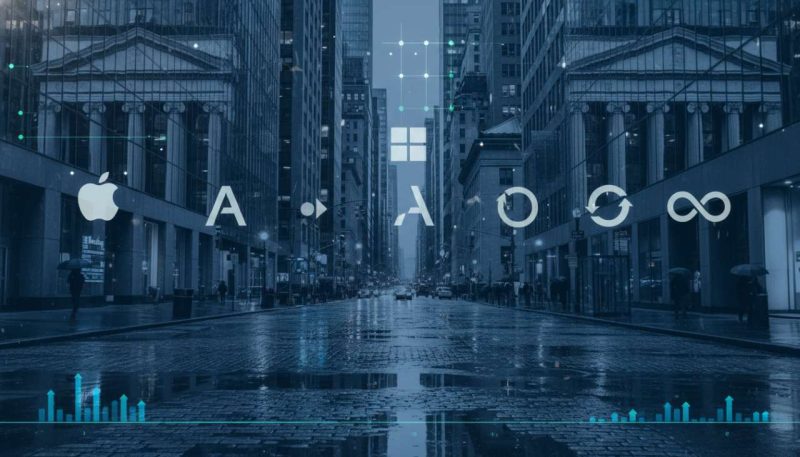
It’s one of those weeks when the market feels like a high‑wire act: Big Tech crowds the earnings stage just as the Fed steps to the mic. Investors aren’t just asking “what did you earn?” but “what regime are we in?” Monetary policy and mega‑cap profit engines have been pulling markets in the same direction for years. This week, they could either harmonize—or clash.
The Fed’s Decision Is About More Than a Quarter Point
Consensus expects the FOMC to cut rates again, with attention pivoting immediately to Chair Jerome Powell’s guidance and the path of easing into 2026. With key economic releases distorted or delayed amid a broader data drought, the qualitative signals in the statement and press conference matter more than usual. Markets are leaning toward another 25 bps cut given moderating inflation and softening labor signals, but the risk isn’t the decision—it’s the dots and tone on how quickly the Fed wants to glide the economy down without reigniting inflation or losing credibility on its 2% target. That’s the tightrope Powell is walking this week. Investopedia previews the decision and backdrop. CNBC’s Jim Cramer likewise frames Wednesday’s Fed move as a likely quarter‑point cut, noting macro data delays have thrown even more focus onto corporate results as a real‑time proxy for the economy (CNBC).
Let’s be clear: if Powell signals a shallower easing path—because growth looks sturdier, equity froth is back, or fiscal policy is inflationary—that’s a headwind to the duration trade and parts of tech multiple expansion. If he opens the door to faster cuts, markets will read that as cover for higher AI capex and consumer resilience. The conversation isn’t just about where the policy rate lands—it’s about who sets prices in this economy: the Fed’s model or Big Tech’s margins.
Big Tech’s Earnings: AI Dreams, Cost Discipline, and Dependence Risk
- Microsoft, Alphabet, and Meta report mid‑week; Apple and Amazon follow Thursday. This is the “systems check” on the AI economy: hyperscaler capex cadence, cloud demand elasticity, and how quickly AI turns from opex to monetizable product. Coverage consensus expects strong prints; some see Microsoft as the standout again among hyperscalers. The setup is rich after a strong run, and disappointments on AI monetization pace could sting. Still, even market skeptics admit these names remain the economy’s live data feed on enterprise spend and ad demand.
- What to watch inside the numbers:
- Capex vs. Free Cash Flow: Are hyperscalers still stepping up AI datacenter spend faster than revenue growth? The durability of 2026–27 AI ROI assumptions will be tested.
- Cloud Workloads: Is optimization finally done, or are customers still rightsizing? Sequential growth and backlog color are key.
- Ads and Engagement: Meta and YouTube face the eternal question—how cyclical are ad budgets into a late‑cycle slowdown and political noise?
- Apple’s Mix: The iPhone cycle’s strength, services ARPU, and China demand are the tells; any commentary on AI features reinforcing the upgrade cadence matters for 2026.
- Amazon’s AWS: Growth trajectory vs. margin expansion is the pivot; outages and reliability chatter can creep into enterprise confidence if not addressed.
- Second‑order sectors: Payments, industrials, and health care also print. Visa/Mastercard color on consumer resilience often leads official data. Boeing, Caterpillar, and UnitedHealth offer a view into capex, supply chain normalization, and cost trends. Expect these to serve as reality checks against tech’s AI‑led narrative arc.
The Macro-Policy Feedback Loop
Here’s the dynamic: The Fed wants to cool the economy without breaking employment; Big Tech wants to keep investing in AI infrastructure without spooking investors on cash returns. If earnings show robust top‑line and disciplined spend, Powell has room to be patient—reinforcing the soft‑landing story. If earnings signal an AI capex wave colliding with a softer consumer and cautious enterprise, the market will beg for faster cuts. That’s why this week is catalytic: the Fed’s dots and the hyperscalers’ capex guides are two sides of the same story—price stability meets productivity promise.
There’s a democratic‑institutions angle too. When official statistics are delayed or politicized, markets default to private‑sector “nowcasts” from a handful of corporations. That’s risky. Policy should be anchored in transparent, timely public data, not earnings call anecdotes. The more we rely on mega‑caps as shadow macro indicators, the more power we cede to firms whose incentives are not the public’s. That’s not an indictment of Big Tech; it’s a plea for functional governance.
Strategy: What Actually Matters for Portfolios
- Watch the curve reaction Wednesday. A dovish surprise that steepens the curve (front‑end down faster than the long end) tends to favor cyclicals and quality growth; a hawkish‑dovish muddle that flattens could keep the AI trade concentrated in the few.
- Earnings quality over headline beats. Clean beats with positive operating leverage and credible 2026 AI monetization commentary should rerate; beats driven by one‑offs or cost cutting without demand breadth risk fade.
- Consumer signal via payments and streaming. Visa/Mastercard volumes and Starbucks traffic are canaries for holiday resilience.
- Don’t ignore energy and industrials. If oil majors and heavy‑equipment names talk disciplined capex and stable demand, it underwrites the soft‑landing narrative more than any single dot on the Fed plot.
The meta‑take: This week is a referendum on whether the AI bull market is still pulling the economy forward—or just levitating multiples on hope. My bias: productivity stories are real but unevenly distributed; policy still matters. Watch Powell’s verbs, not just the basis points.
